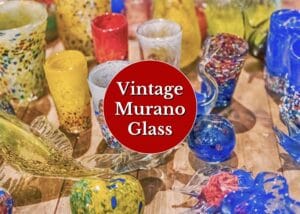Whether you’re a collector or not, you must’ve heard about Murano glass once or more in your life, but didn’t pay attention. Does the name ring a bell?
Yes, I’m talking about those colorful glass pieces with unique swirls, stripes, and bubbles INSIDE IT! Those are quite popular today among collectors, who are ready to pay thousands! And there is always a slight chance you have it in your home, but didn’t recognize it!
Don’t worry! With this guide, not only will you be able to spot real Murano glass, but you’ll also understand what affects its value with some real examples sold at sales and auctions – everything you want to know about the iconic Venetian glass!
What Makes Murano Glass Different & Special?
Any glass originally made on the island of Murano, Venice, Italy, is Murano glass. This happened after the Venetian government forced all glassmakers to move their workshops to Murano in the late 13th century!
For centuries, families perfected their craft in isolation and developed techniques that still blow people’s minds today. What makes Murano glass so special is these unique techniques – each family guarded their methods! That’s why authentic Murano glass has qualities you won’t find anywhere else.
3 Key Signs to Identify Real Murano Glass
Spotting a real vintage Murano glass from many colored blown glass pieces can be tedious. But as I said above, Murano glass displays some unique characteristics that modern glass just can’t replicate. And it’s not just the looks!
So, here is a detailed breakdown of the key signs of identifying Murano glass!
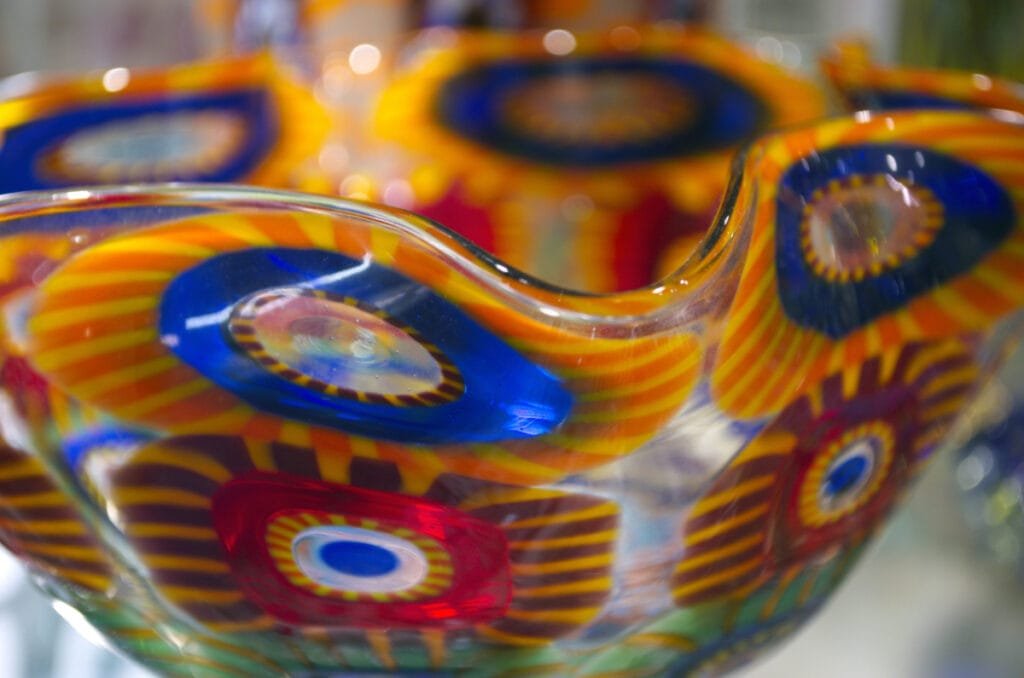
1. Glass-making Techniques
The first step to identifying real Murano glassware is to find out what technique it’s made with. Since the 15th century, artisans in Italy have discovered and used several unique techniques and methods to create glassware, which themselves distinguish it!
Here are some of the most popular Murano art glass-making techniques:
- Cristallo: In the 1400s, Angelo Barovier cracked the code on making glass so crystal-clear it rivaled actual rock crystal. For centuries, Murano was the only spot in Europe where glass was made using the new technique.
- Millefiori: Millefiori means “thousand flowers.” In this method, artisans create colorful glass rods and then cut cross-sections, resulting in detailed flower designs. You can easily spot this glass by its unique floral pattern.
- Sommerso: Italian term meaning “submerged,” Sommerso involves layering different colored glass to create depth. The layering is mostly with the transparent colors over the opaque ones to create a multi-dimensional effect.
- Filigrana: This method is about weaving fine threads or rods of colored or opaque glass (often white, called lattimo) into clear glass. It’s also done in different ways: Retortoli (two or more filigree rods get twisted together), Zanfirico (parallel white and colored threads twisted in opposite directions).
- Avventurina: This technique involves mixing metallic bits, usually copper shavings, into molten glass, resulting in a mineral-like sparkle throughout.
- Bullicante: This technique creates controlled air bubble patterns inside the glass. The bubbles are added on purpose and often arranged in regular, grid-like formations, giving pieces a textured, bubbly look.
The signs of these techniques are vital authentication tools! While Real Murano glass strictly used these methods, fakes usually rely on paint or simpler techniques.
2. Maker’s Marks and Labels
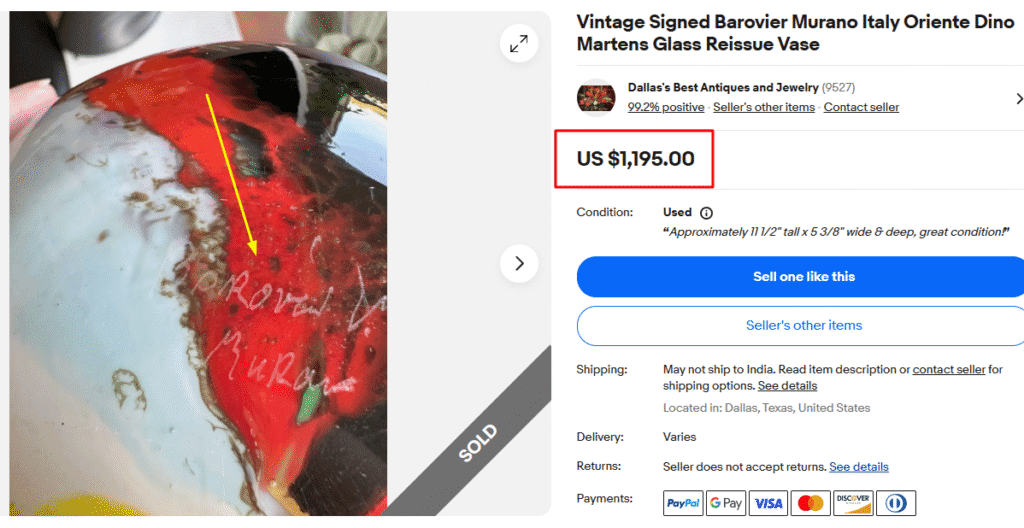
Those etched marks you’d often see on vintage Murano glass are foolproof identification clues, but only if you know what they mean. Let’s understand in detail:
Certification of Authenticity
Since 1980, legitimate Murano glass has come with certificates of authenticity. And pieces made after 1985 bear the official “Vetro Artistico Murano” trademark. It’s a legally protected mark and quite hard to fake; you’ll know when you see it.
But vintage Murano pieces that predate this system may have neither a certificate nor the “Vetro” marking. In such cases, you need to learn to have an eye to recognize the real Murano treasure.
Studio or Artists’ Signatures
Many valuable vintage Murano glass pieces, especially from famous maestros or important periods, may have the studio or artist’s signature on the base.
Some of the most popular names that are synonymous with Murano glass are:
- Venini: Known for groundbreaking designs, often working with famous architects and designers like Carlo Scarpa, Gio Ponti, and Paolo Venini himself.
- Barovier & Toso: One of Murano’s oldest glass families, Barovier is famous for innovating and mastering ancient techniques in both traditional and modern pieces.
- Seguso Vetri d’Arte: Famous for solid, sculptural glass forms, often using sommerso and bullicante techniques, with notable artisans like Alfredo Barbini and Archimede Seguso.
- Archimede Seguso: Known for intricate filigree work, lattimo, and solid sculptures.
- Alfredo Barbini: Celebrated for his massive, often sculptural forms, particularly in sommerso and bolle (large bubbles).
- Dino Martens (for Aureliano Toso): Recognized for bold color use, asymmetrical forms, and experimental techniques.
- Fulvio Bianconi (for Venini and other studios): An influential designer known for whimsical and vibrant figures (like the Pezzati series) and innovative forms.
- Vittorio Zecchin (for Venini): Influential early 1900s designer known for delicate, lightweight forms inspired by Venetian painting.
These signatures are usually etched or engraved right into the glass. If you see a signature, research and check it against known examples.
Remember that not all genuine vintage Murano glass is signed, especially older pieces or smaller production items like drinking glasses, goblets, or some chandeliers.
Labels:
From the mid-1900s onwards, companies and studios began adding adhesive paper or foil labels to Murano glass pieces. These labels usually show the studio name, “Murano,” and “Made in Italy.”
But the labels aren’t always reliable, as they can be easily faked, removed, or fall apart over time. So, a label by itself may not prove the authenticity. But combined with physical characteristics, it helps. If there, the label should also display signs of age and wear.
Note: Many colors and designs were used by several makers in different periods, meaning a 1920s vase may resemble one made in the 50s or later.
3. Physical Features
Once the Murano glass piece is ready, it displays certain physical characteristics that speak of its origin and uniqueness, such as:
- Weight: Authentic Murano glass feels lighter than you think. Mass-produced pieces, especially those from China, are usually much heavier. So, always pick up the piece and feel its weight. If it feels too heavy, be alarmed.
- Color: Generally, most Murano glassware colors let a lot of light through them. And these colors come from mineral oxides mixed right into the glass while it’s melting, so the color is part of the glass, not just painted on top.
- Lead Absence: Vintage Murano glass doesn’t typically have lead in it, so it won’t sparkle like leaded crystal. Instead, it has its unique shine and clarity that comes from the purity of the silica sand used.
- Sound: Since it isn’t crystal, Real Murano glassware does NOT create a sharp ‘ping’ sound when tapped.
- Pontil Marks: This is a sign of age! Real vintage Murano glass pieces should bear a rough spot on the bottom called a pontil mark (where the glassmaker broke off the metal rod after finishing the piece). It’s like a small, rough scar.
- Imperfections: Those small bubbles and swirls inside the glass are natural flaws that prove authenticity. Since vintage Murano glass is hand-blown and shaped without precise measurements or machines, each piece is unique!
My Tip: Scratch the glass piece. If the color peels off with your fingernail, it’s fake.
What Makes Vintage Murano Glass Valuable? (6 Factors)
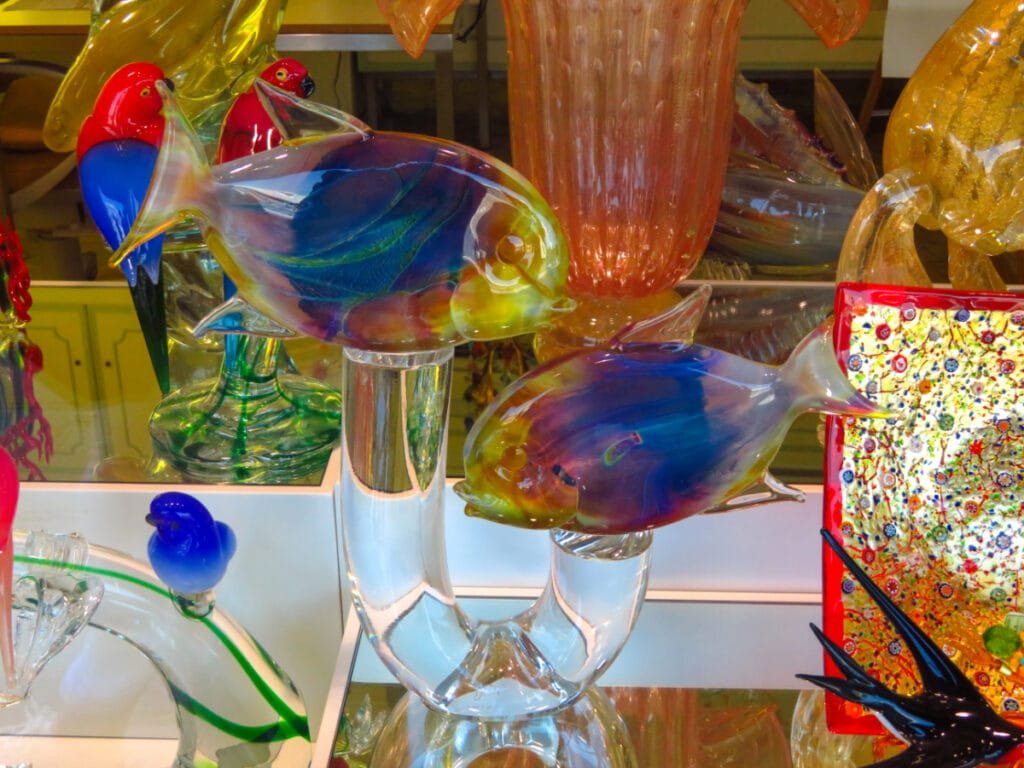
In recent years, vintage Murano glass has come up as a hot collectible, fetching mind-blowing prices of up to $10,000 or even more!
But all vintage Murano pieces need not be valuable! The actual worth comes from several factors – its artistic quality, age, condition, and mostly from what collectors are willing to pay.
Nonetheless, understanding these factors will help you know whether a piece is worth big money or just a few bucks.
Authenticity
For a vintage Murano glass to be valuable, it has to be, well, Murano! If a piece wasn’t made on Murano Island using traditional methods, its value crashes, no matter the design. With fakes and “Murano style” reproductions around, you must authenticate the piece through history, markings, or physical features!
Brand/Studio Reputation
Which glassworks or individual maestro created the glass piece greatly impacts the value. Some studios and artists became internationally famous for their innovation, artistic vision, and technical mastery. Pieces from these big names cost more.
Craftsmanship and Technique
More complex Murano pieces that display challenging and time-consuming techniques like reticello, zanfirico, incalmo, and intricate millefiori are more desirable than simple ones. The more elaborate and perfectly executed the technique, the higher the value.
Rarity & Uniqueness
An antique Murano glass piece that is generally hard to find will automatically be highly sought-after. Several things make vintage Murano glass rare:
- Retired Studios: Some studios only operated for short periods. AVEM, for example, only existed from 1947 to 1972. Pieces from such studios are generally difficult to find.
- Unique Designs and Limited Editions: Prototypes, one-time creations, or glassware pieces from tiny production runs are naturally rarer.
- Discontinued Lines: Items from lines that studios don’t make anymore, especially by famous designers or studios, are considered rare. For Fulvio Bianconi’s “Fasce Orizzontali” bottles!
- Unusual Shapes or Sizes: Pieces that look different from typical forms or are unusually large or small for their type can be quite rare.
- Survival Rate: Very old Murano glass pieces that have made it through centuries in good shape against all odds are also rare finds!
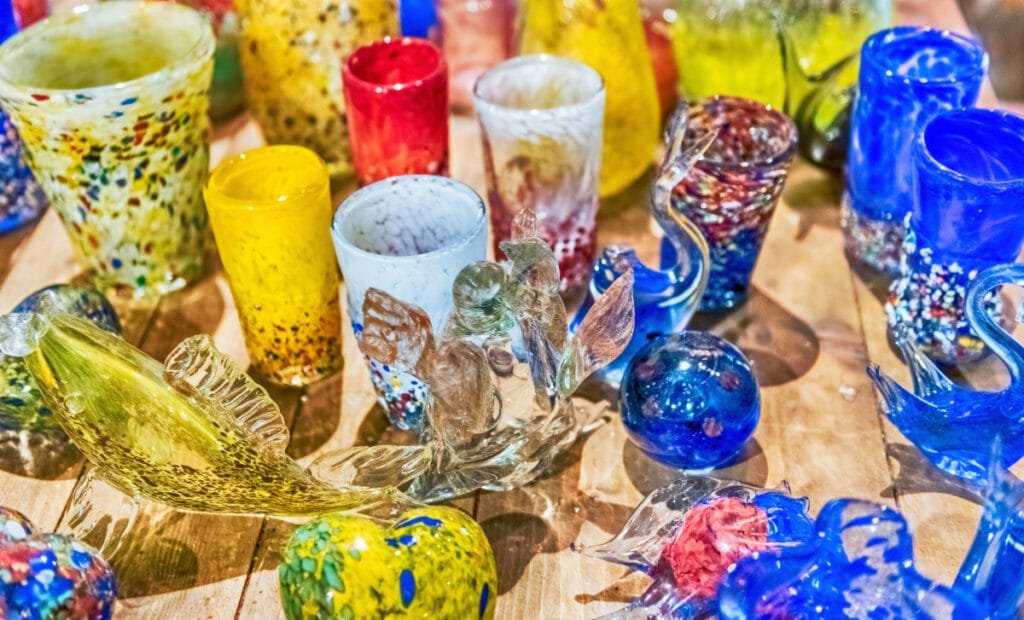
Condition
The condition can make or break the deal! Why? Because even a rare piece by a famous maker loses its worth if it’s seriously damaged. So, keenly assess the glassware’s condition to evaluate its value.
Here are some damages that put collectors off:
- Chips: Especially on edges, bottoms, or any protruding parts
- Cracks: Hairline cracks or bigger splits
- Deep Scratches: While minor surface scratches are okay (on older pieces), deep or widespread scratches are a big no.
- Restoration: Professional, invisible repairs might make it through, while sloppy repairs can make a piece almost worthless.
- Loss of Original Elements: Broken applied parts or lost special finishes
- “Sick Glass”: Poor quality glass that looks cloudy or shows surface iridescence that won’t clean off
My Tip: Make sure to check the piece carefully under good light. Run your hands all over to feel for any kind of problems or damages.
Provenance & Documentation
Exceptional vintage Murano glass pieces that also have a well-documented history can be significantly valuable! Being able to know who owned the piece (especially important figures), where it’s been, etc., always pulls serious collectors.
Similarly, a glass piece that was once a part of a significant exhibition can be highly collectible. But you will need proof to verify this kind of history.
That’s why documentation matters. From original receipts/invoices and labels or tags to factory records, exhibition catalogs/photos, the inclusion of important documents and proofs adds a lot of credibility and value to old Murano glassware.
15 Rarest Vintage Murano Glass Pieces That Are Super Valuable!
Let’s take a look at some of the most valuable Murano glass pieces to understand the rare techniques they feature and how they impact the actual values.
1. Monumental Alfredo Barbini Fish Sculpture
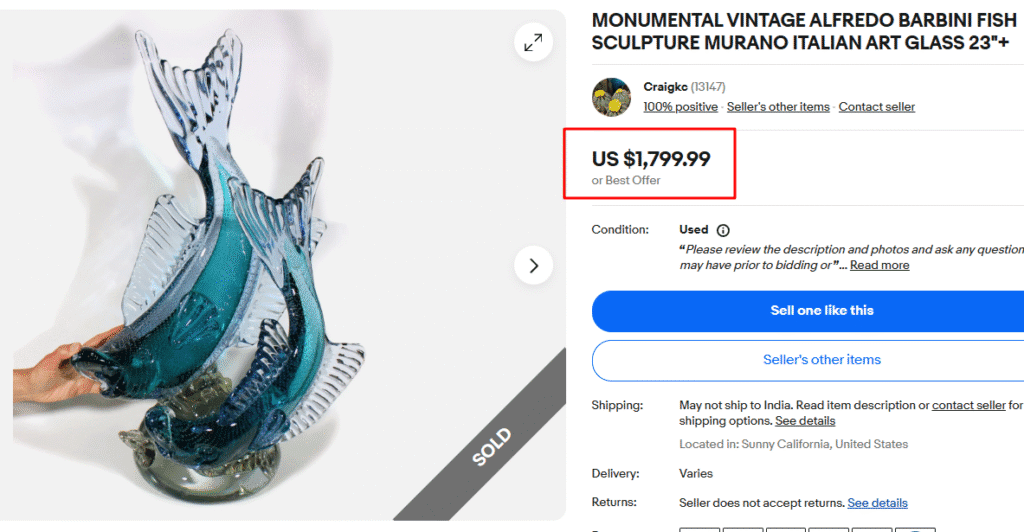
- Brand/Designer: Alfredo Barbini
- Glass Type: Bubbles in Glass
This massive fish sculpture from Alfredo Barbini is proof of why he was known as one of the greatest glass artists ever. This stunning piece reflects his skills in every glass technique – the clear glass with blue-green colors inside, with all those controlled bubbles!
Being a Barbini design, this piece deserved to be valuable, but what further upped the price is its unusually huge size of 23 inches! Large Murano pieces have quite a low survival rate, so finding one, that too, in such a fresh condition, is rare.
2. Giancarlo Signoretto Clown on Scooter Figurine
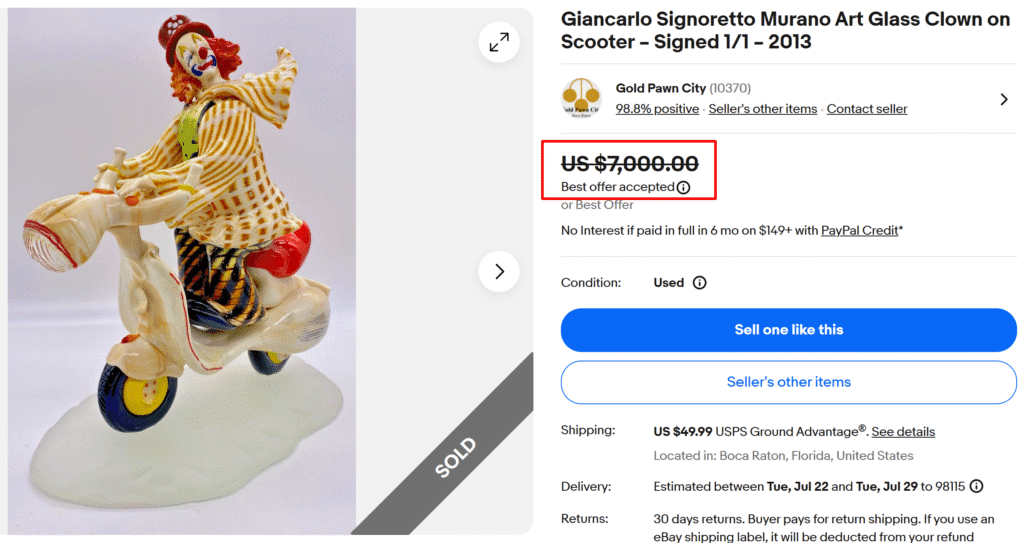
- Brand/Designer: Giancarlo Signoretto
- Glass Type: Multiple
This ornate clown on a scooter Murano glass sculpture is designed by Giancarlo Signoretto, part of the famous Signoretto family (his brother Pino was legendary). It’s a signed piece, marked “Giancarlo Signoretto” at the bottom, meaning it’s totally authentic!
Such complex sculptures with all the details (the clown’s outfit and the scooter) are extremely difficult to make with glass, making them desirable today. Besides, it’s a true reflection of Signoretto’s hot modeling technique.
3. Flavio Poli Murano Pezzati Glass Vase
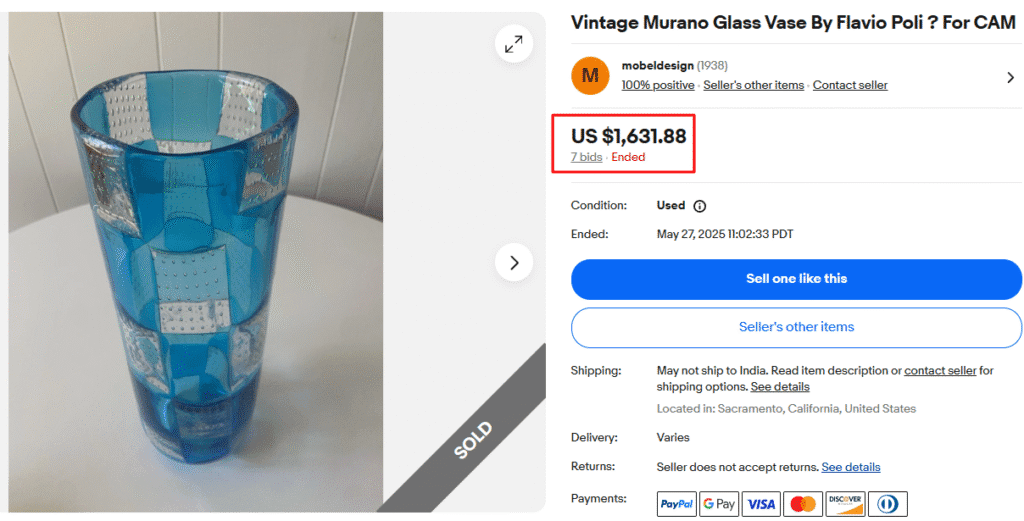
- Brand/Designer: Flavio Poli
- Glass Type: Similar to Pezzati
This clean and modern-looking vase from Flavio Poli combines the mosaic style (similar to Pezzati from Fulvio Bianconi), in which patches of different colored glasses are connected, creating a beautiful patchwork, with the bullicante or pulegoso style (bubbled glass).
The geometric pattern and simple colors reflect the clean, modern look popular in the 1960s, something different from the flowery stuff that came before. Pezzati glasses are extremely rare today, and the fact, apart from being a Poli piece, that it resembles the style, is why this vase fetched over $1,630!
4. Barovier Murano Oriente Dino Martens Signed Vase

- Brand/Designer: Dino Martens
- Glass Type: Multiplate (Oriente)
This exotic and super unique vase is from Dino Martens’ “Oriente” series, known for blending every cool glass technique into one piece. So, you’ll see colorful patches, sparkly bits (that’s aventurine), thin lace-like designs (Zanfirico), and those star patterns mixed throughout.
Martens originally made these crazy designs in the 1950s, and they were a big hit; companies kept making them for decades. Early Oriente pieces can fetch $1,000 to $2,000+ or more, like this piece, in excellent condition!
5. 1950s Flavio Poli Murano Sommerso Vase

- Brand/Designer: Flavio Poli
- Glass Type: Sommerso
This bulbous vase is a perfect example of Poli’s famous “sommerso” technique, in which they dip colored glass into clear glass to create amazing layers. You can see the purple melting into blue, then clear glass on the outside.
Besides, the cleanly cut edges make the piece sparkling. What makes this piece desirable, as we can tell by its steep price of $1,200, is that it was designed by Poli, the top designer at Seguso in the 1950s. Finding these pieces in pristine condition is a collector’s dream!
6. Fratelli Toso Millefiori Murano Glass Box
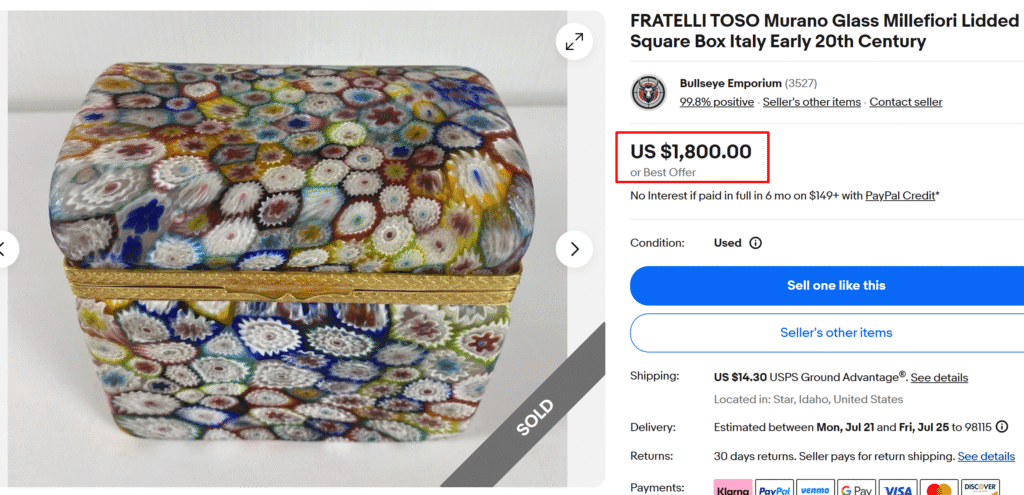
- Brand/Designer: Fratelli Toso
- Glass Type: Millefiori
This is an extraordinary Murano glass piece from Fratelli Toso featuring their iconic “millefiori” work, which means “thousand flowers!” Each flower you see is a slice from a glass cane made by bundling different colored glass rods together, then slicing them like salami.
This technique is super old, but Fratelli Toso perfected it in the early 1900s. Authentic pieces with millefiori glass, especially in unusual shapes like a box with a lid, in excellent condition, are quite rare today, making them super valuable; no wonder this piece sold for $1,800!
7. Salviati & Co. Uranium Glass Kiwi Bird Sculpture

- Brand/Designer: Salviati & Co.
- Glass Type: Uranium
This is a cute bird sculpture from Salviati! It’s made with uranium glass, something Antonio Salviati was best at! You can see the fine details in the beak and the eyes. The uranium glass (also called vaseline glass) glows under UV light (it was popular in the early to mid-1900s).
Salviati is an important name in the Murano glass industry as he innovated with many experimental techniques and materials. They tried reviving Murano’s glass industry in the 1800s after it had declined, and their pieces often featured bold colors and innovative techniques!
8. 1960s Fulvio Bianconi For Venini Swirl Lamp Shade
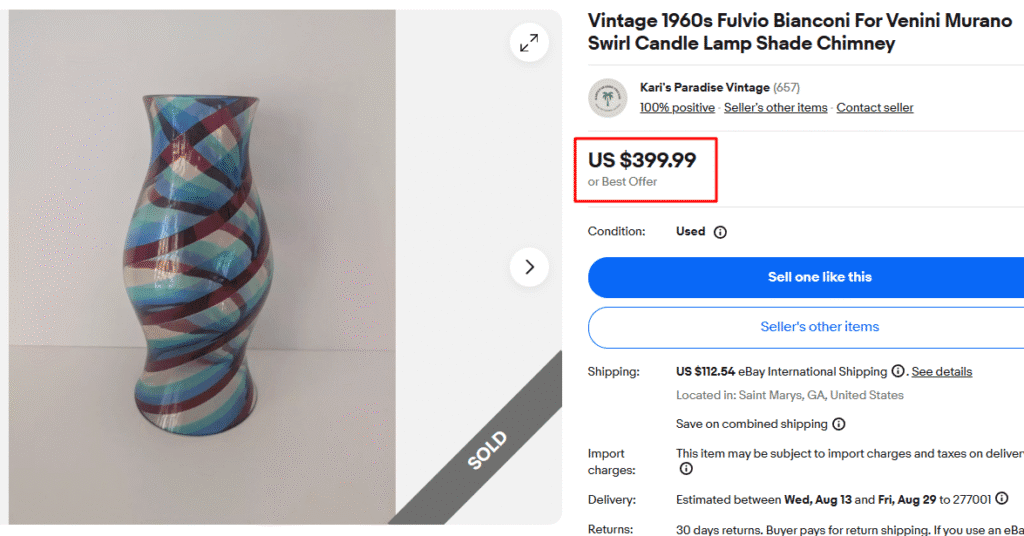
- Brand/Designer: Venini
- Glass Type: Twisted Ribbon
The gorgeous swirls on this lamp/candle shade tell you it’s from Bianconi, a master at making these twisted ribbon patterns that appear to move! Authentic Venini pieces always show such bold and vibrant colors.
Bianconi worked with the famous Venini company and created some of the coolest glass designs, like this! His work is in major museums now, so getting a piece like this for under $400 must’ve been a steal!
9. Mandruzzato Sommerso Casket Jewelry Box
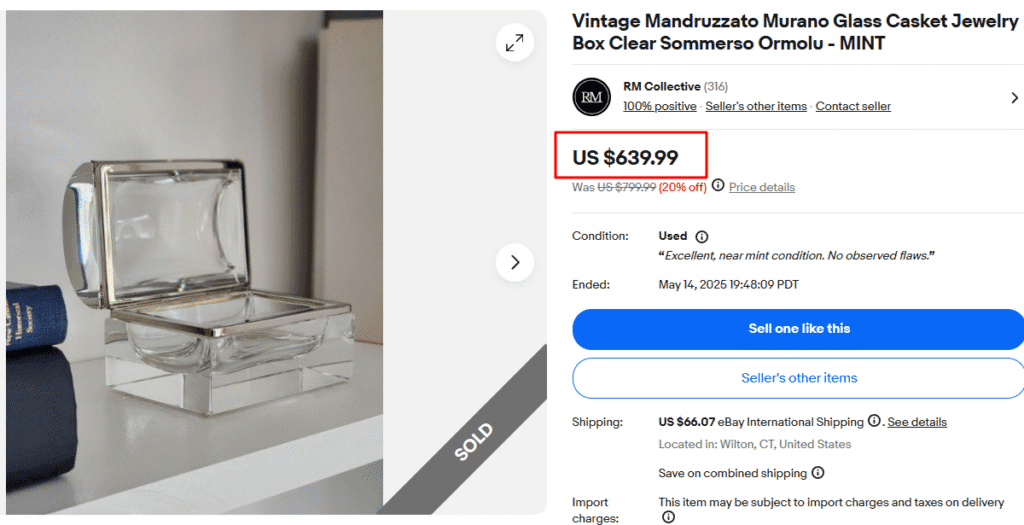
- Brand/Designer: Mandruzzato
- Glass Type: Sommerso Ormolu
This clear glass casket with its geometric, faceted design is a true example of Mandruzzato’s style. It’s a simple, clear glass casket made in the sommerso style with ormolu decoration on the edges.
Mandruzzato popularized such geometric-shaped vases, bowls, and other items that deviated from the older extravagant pieces. This clear jewelry box also reflects its expertise in cold-working techniques, grinding and polishing the glass after it cools to give it perfect shapes.
Colored examples of this piece can be worth even more than the $640 price tag this piece acquired.
10. Venini Reticello Glass Caged Pendant Chandelier
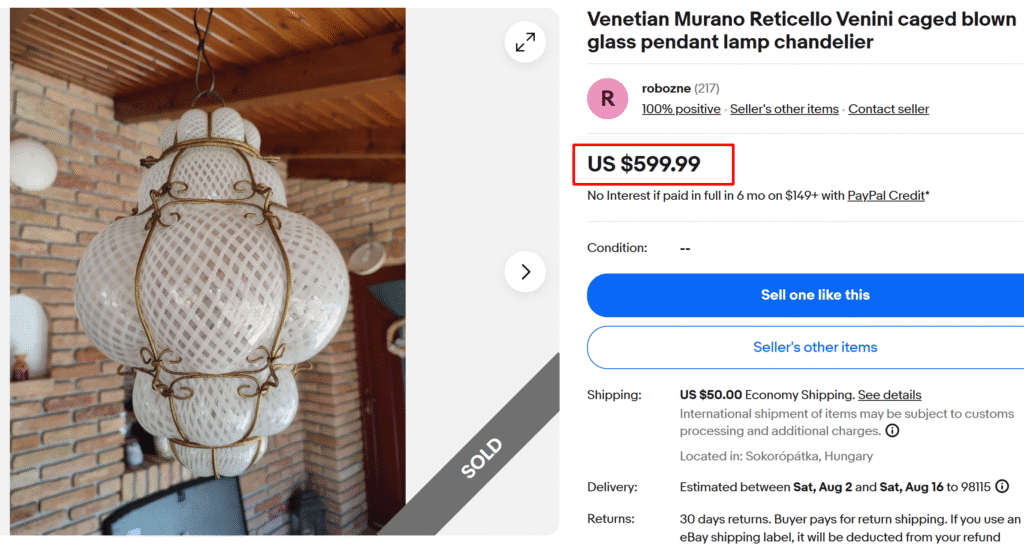
- Brand/Designer: Venini
- Glass Type: Reticello
What you see on this super rare blown glass chandelier is the classic reticello technique, in which artisans make a net-like pattern within the glass by rotating and intertwining thin threads of glass, and wrap it with clear glass.
Since it’s a vintage piece, the “caged” framework is all made of brass, adding more to the value! Venini’s or other Reticello Murano glass pieces, especially large pieces like this lamp, can be highly valuable due to their mesmerizing appearance!
11. Archimede Seguso Gold And Pink Bullicante Bowl
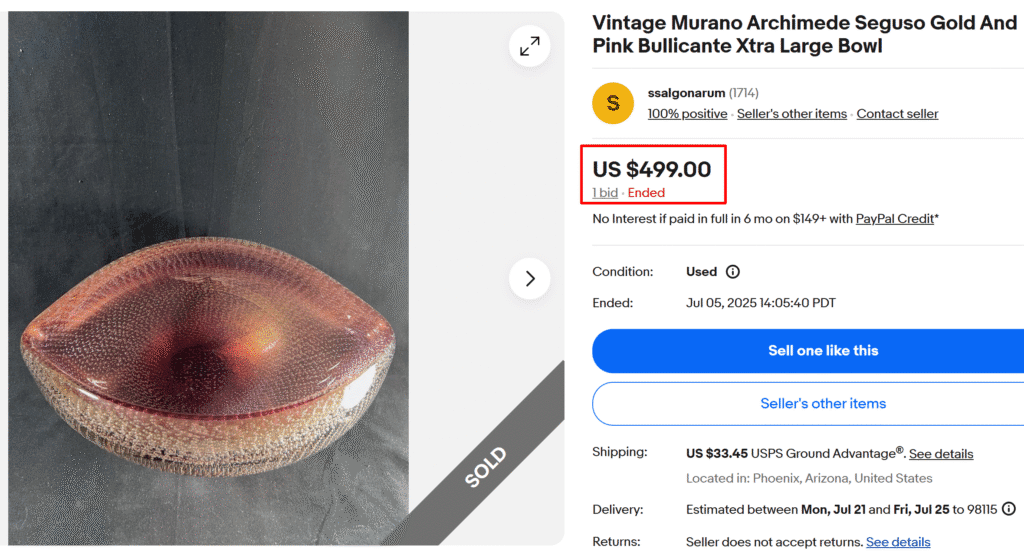
- Brand/Designer: Archimede Seguso
- Glass Type: Bullicante
This large Seguso bowl shows off the “bullicante” technique, identified by those controlled tiny bubbles that look like pearls trapped in the glass. You can spot the amazing blending of the pink and gold colors throughout the piece.
Real Bullicante Murano glass is quite rare because it took incredible skill from the glassmaker to control exactly where each bubble goes. Also, the massive size of this bowl is another reason it was bought for almost $500!
12. Venini Carlo Scarpa Mezza Filigrana Bowl
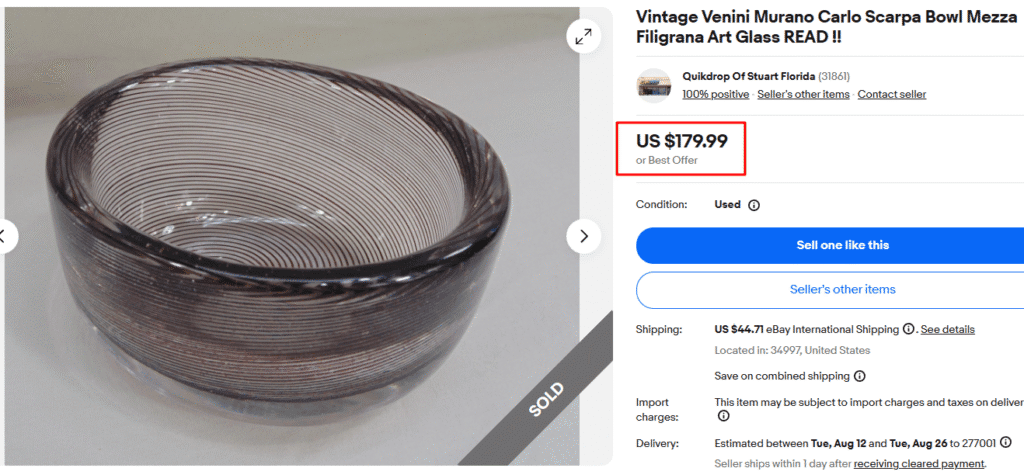
- Brand/Designer: Venini
- Glass Type: Filigrana
This stunning bowl from Venini is made with the mezza filigrana technique, which requires artisans to create fine stripes within the glass. Apart from this special technique, this piece is rare as it belongs to Carlo Scarpa, as signed at the bottom!
Scarpa joined Venini as artistic director in 1932, and two years later, created the Mezza Filligrina series of paper-thin bowls with impossibly fine stripes. These pieces are incredibly sought after today and often sell for much more than this bowl’s $180 price tag.
13. Archimede Seguso Lattimo Pink Gold Ashtray
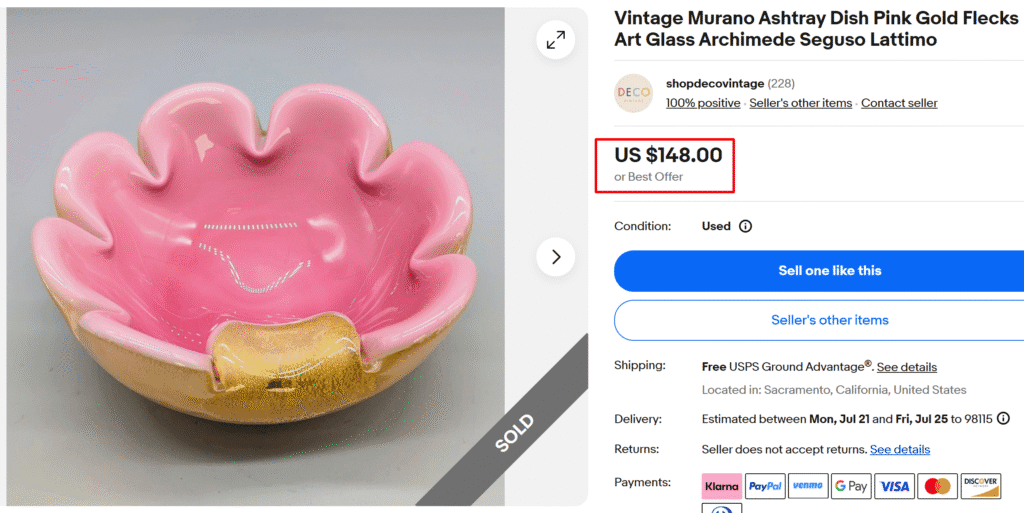
- Brand/Designer: Archimede Seguso
- Glass Type: Lattimo
This cute Murano ashtray from Archimede Seguso is “lattimo” glass (that means milky in Italian) with gold flecks scattered throughout. You can see the glassmaking mastery in those scalloped edges and flowing shape – for a moment, you’ll forget it’s glass!
Lattimo glass is tricky to make, making such curvy and colorful pieces highly rare. Also, Seguso pieces are in major museums worldwide, so such signed pieces can easily fetch $100-$800+!
14. Mid-Century Modern Pulegoso Pink Aventurina Bowl

- Brand/Designer: Unknown
- Glass Type: Pulegoso & Aventurina
This stunning Murano glass bowl features the “pulegoso” technique, which involves filling the glass with thousands of tiny bubbles to make it look like foam. You can see the pretty pink and blue colors with bubbles trapped inside and some sparkly aventurine bits mixed in.
The name “pulegoso” literally means “full of fleas” in Italian. This glassmaking technique was introduced in the 1920s by adding special salts to the glass while it was hot. This creates bubbles inside the glass, so you won’t feel them on the surface.
15. Alfredo Barbini Incalmo Murano Glass Vase
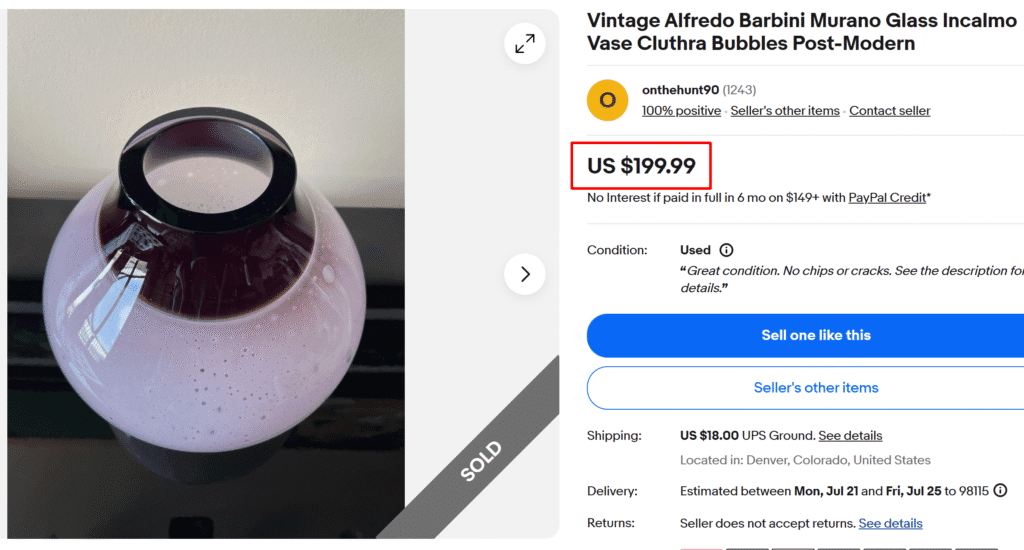
- Brand/Designer: Alfredo Barbini
- Glass Type: Incalmo
This mesmerizing vase showcases Alfredo Barbini’s mastery of the incalmo technique, in which two different colored glass sections are joined together while hot. It also features the cluthra effect, with those beautiful controlled bubbles scattered throughout the glass.
Alfredo Barbini was one of the biggest names in 1950s Murano glass, known for his thick, sculptural forms. His incalmo glasswork is extremely popular today!
Note: This article is intended for informational, educational, and entertainment purposes only. Some images are illustrative and may not represent actual brands, products, or related entities. All trademarks, product names, brand logos, packaging, and other intellectual property referenced remain the exclusive property of their respective owners. Any brand mentions or references are provided solely for descriptive and educational context and do not imply any formal or commercial association.

